|
ALEXANDRIA
The
Pompey’s Pillar:
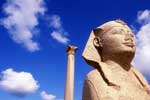 It is a huge granite pillar, about 27 ms high, dates from the
third century amidst the remaining relics of the Serapium. The
pillar was erected in honour of the Greek emperor Diocletian. It is a huge granite pillar, about 27 ms high, dates from the
third century amidst the remaining relics of the Serapium. The
pillar was erected in honour of the Greek emperor Diocletian.
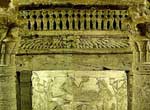 Catacombs
of Kom Al Shuqqafa: Catacombs
of Kom Al Shuqqafa:
This is the largest Roman cemetery. They consist of Three levels
cut in the rock to a depth of 100 feet. Dating back to the turn
of the 2nd century AD, it is a blend of Pharaonic and Roman art.
The Greeco-Roman
Museum:
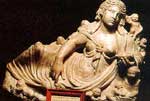 It tells the story of the invasion of Egypt by Alexander the
Great and the building of Alexandria. It houses many collections
of rare Greek and Roman relics and coins, about 40 thousand
pieces, dating from the 3rd century BC till the 7th century AD.
The most important and the priceless statues in the Museum is
the “Tanagra” statues. It tells the story of the invasion of Egypt by Alexander the
Great and the building of Alexandria. It houses many collections
of rare Greek and Roman relics and coins, about 40 thousand
pieces, dating from the 3rd century BC till the 7th century AD.
The most important and the priceless statues in the Museum is
the “Tanagra” statues.
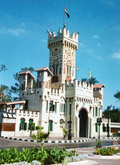 Montazah
Palace: Montazah
Palace:
It was built east of Alexandria on a high hill and overlooking
the most beautiful beach of Alexandria, amid about 370 feddans
of gardens and woods. The Palace comprises of a group of
buildings of which the most important are being Al-Haramlek, of
which the first storey has been transformed into an
international casino, the second and third stories into a museum
for the belongings of the former royal family.
But Al-Salamlek building has been transformed in luxurious
Hotel. Another Hotel has also been built in the garden
overlooking one of the most beautiful bay surrounded by green
areas.
Qaitbay
Citadel:
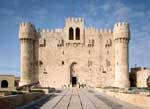 It lies in the northern tip of the eastern harbor, on the site
where the ancient Pharaos of Alexandria was set up. This fort
was built in the 15th century by Qaitbay, and it consists of
three stories similar to medieval fortresses in Egypt. It also
houses the naval museum, which revives the marine heritage of
Alexandria. This museum combines models, paintings and statues
portraying the development of navigation and ship building in
Egypt since Pharaonic times until the present. They also
represent the Egyptian sea battles throughout the ages. It lies in the northern tip of the eastern harbor, on the site
where the ancient Pharaos of Alexandria was set up. This fort
was built in the 15th century by Qaitbay, and it consists of
three stories similar to medieval fortresses in Egypt. It also
houses the naval museum, which revives the marine heritage of
Alexandria. This museum combines models, paintings and statues
portraying the development of navigation and ship building in
Egypt since Pharaonic times until the present. They also
represent the Egyptian sea battles throughout the ages.
 Al
Anfuschi Tombs: Al
Anfuschi Tombs:
They lie in front of Ras El-Teen entrance. There are five tombs
in the area, but two of them are considered the most important.
They were discovered in 1901and date back to the Ptolemaic era
in the third century BC. The two tombs are distinguished by
their beautiful engravings and unique architectural design.
The Tombs
of Mustafa Kamel:
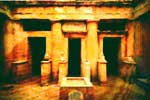 Located in the Roman Camp Street, Rushdi. They are four
catacombs, from the Ptolemaic era, dating back to the second
century BC. It is a unique subterranean rock-hewn tomb, as it is
the only tomb discovered east of Alexandria and is distinguished
from the rest of the Ptolemaic tombs by its well preserved
relieves and architectural style. Located in the Roman Camp Street, Rushdi. They are four
catacombs, from the Ptolemaic era, dating back to the second
century BC. It is a unique subterranean rock-hewn tomb, as it is
the only tomb discovered east of Alexandria and is distinguished
from the rest of the Ptolemaic tombs by its well preserved
relieves and architectural style.
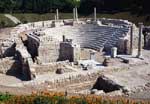 The Roman
Amphitheater: The Roman
Amphitheater:
It is a small Roman Amphitheater, recently discovered in the
area of Kom El Dekka, near the Greco-Roman Museum. The Theater
is considered as the only relic of its kind in Egypt for it has
12 rows of semi-circular marble seats and the theater is in good
condition. |